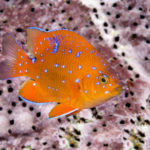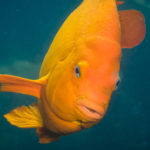You're strolling through an enchanted forest. Mist hangs in the air. The gentle light filters through opaque leaves of the soaring trees, which gently sway in the light breeze. Suddenly a forest sprite appears, vivid in electric orange that cuts through the gloaming. Another appears. Then another, like fireflies in summer dusk. You half expect Treebeard to scoop you up and accuse you of being an orc. But this isn't Middle Earth, and you're not a character in the Lord of the Rings. You're diving the famed kelp forests of southern California, and you've just spotted your first garibaldi.
What is a garibaldi?
Garibaldis are a bit like 30-something New Yorkers. They typically live alone but in close proximity to each other, in what one might call one-bedroom apartment blocks along the reefs from Baja California to Monterey Bay. Garibaldi seek rocky nooks in relatively shallow water (up to 45 feet/14 m) with convenient access to their dietary mainstays of sponges and algae, which probably account for their bright orange color. They also sometimes eat invertebrates such as tubeworms, bryozoans or even nudibranchs. When it's not nesting season, they'll occasionally rise into the water column and gather in groups, possibly to scope out the competition and/or mates.


The largest of the damselfish family — up to 15 inches (38 cm) long — the common description of a garibaldi as a "giant goldfish" doesn't do justice to its pedigree. Indeed, it is named for Giuseppe Garibaldi, the 19th-century Italian general whose volunteer army, clad in idiosyncratic red shirts, fought battles that eventually led to the unification of Italy. Military historians consider him one of the greatest generals of all time. Italians remember him as one of their "fathers of the fatherland." He was also a celebrity, feted by writers and intellectuals like George Sand, Alexander Dumas and Victor Hugo. To equate his namesake with a fish you might win at a fair and dispose of down the toilet when it passes seems inadequate and even disrespectful.
Where can you see one?
Indeed, the garibaldi's name is apt not only because of its distinctive color. First, it is a patriot (of sorts). Like most damselfish, the male will fiercely defend its nest site — usually a little garden of red algae — from all perceived predators, even divers (and their cameras). The local population also reveres the garibaldi: it is, after all, California's state marine fish. Finally, it's a minor global celebrity. Because it is endemic to California's coastline, divers know that they must come to southern California to see one. And any diver in this environment will see one. There are few guarantees in underwater critter-hunting. But a garibaldi sighting anywhere from Santa Catalina Island near Los Angeles, to La Jolla Cove in San Diego, is as close as you can get.
The post Marine Species: Garibaldi appeared first on Scuba Diver Life.
from Scuba Diver Life http://ift.tt/2tMspBN
No comments:
Post a Comment